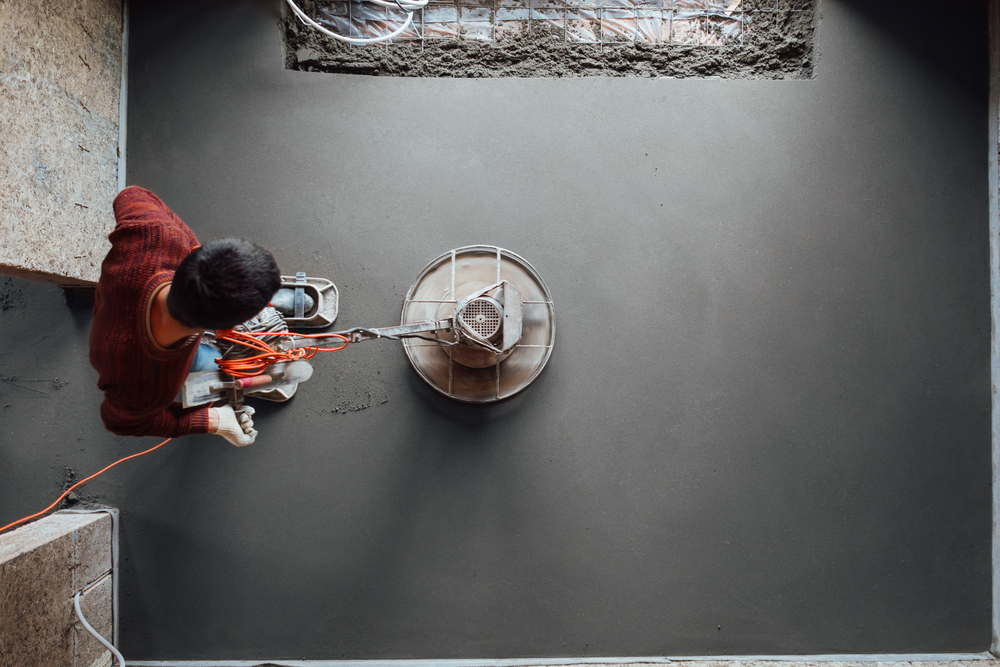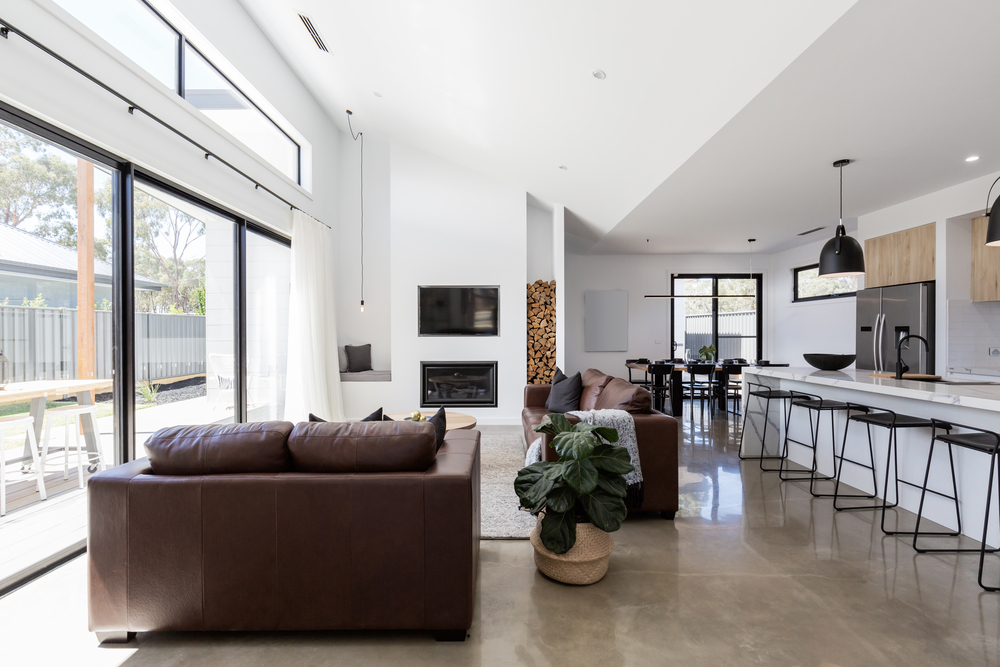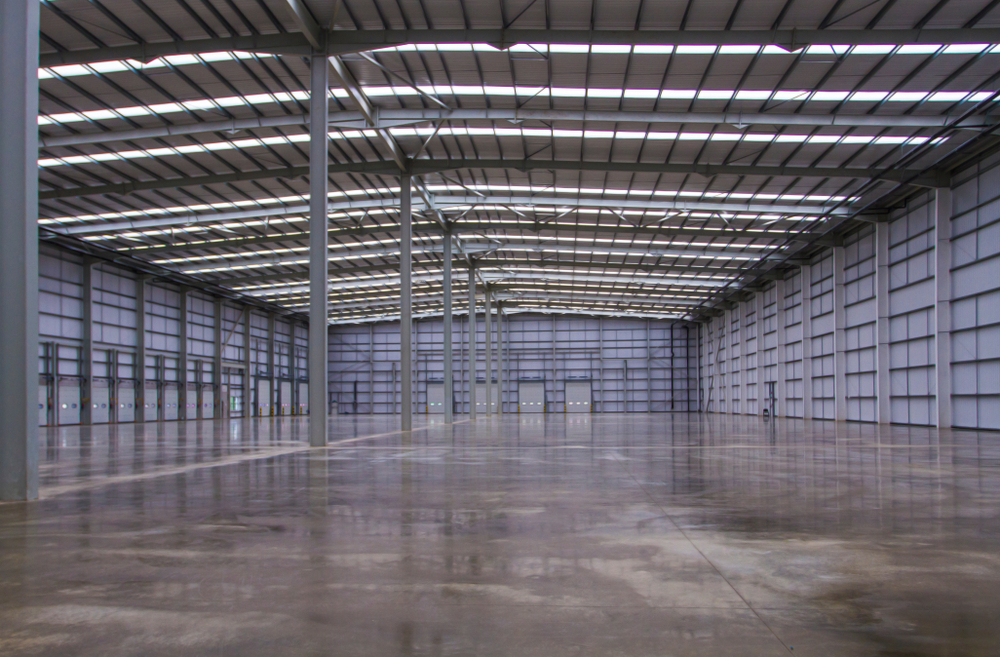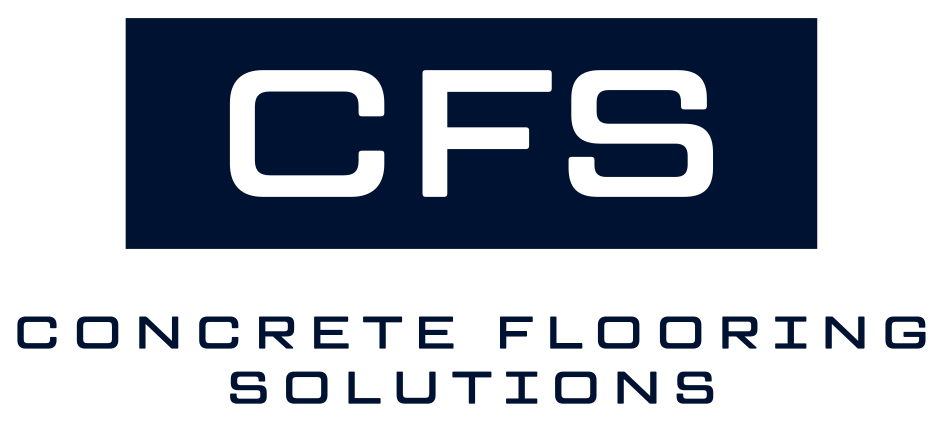How Much Concrete Is Removed From Polished Concrete Floor?
Polishing concrete is a great way to keep your concrete floors looking nice and in good condition. How much concrete is removed during polishing? Not much, so you can polish the floors numerous times during the floor’s lifespan. This gives the floor an appealing shine that looks great in a variety of locations, including homes, offices, warehouses, and more. A polished concrete floor is a durable and attractive option for many spaces. Interested in polishing your concrete floors? Here’s what you should know before getting started with a polished concrete floor.
What is Concrete Polishing?

Concrete polishing is the process of grinding the surface of concrete using special equipment to achieve a smooth and shiny appearance without the need for an epoxy resin or wax coating. It’s similar to sanding a piece of wood with sandpaper. Diamond abrasives are used to grind down the top of the concrete, removing blemishes and adhesives and making the polished concrete floor look nicer and shinier. This process is often used to create a durable and aesthetically pleasing polished concrete floor that requires minimal maintenance over time.
The Polishing Process
The polishing process involves several steps to get the concrete to the desired level of smoothness. This process should be performed every two to three years, depending on the amount of wear and tear and exposure to the elements your concrete floor receives.
Clean the Floors
The first step in the polishing process is cleaning the floor. Grinding the surface of the concrete removes resin, paint, glue and other adhesive materials, and more. For adhesives that won’t budge, chemical removal may be necessary. Cleaning the floor reveals a concrete surface that can be further grinded and treated to create a smooth surface.
Fill Cracks
After you have removed adhesives and other gunk from the surface of the concrete, you’ll want to fill in cracks and joints in the concrete using an epoxy resin or joint filler. This helps prevent cracks from growing and causing problems for your floor.
Grind the Concrete
Now, it’s time to grind the concrete. Diamond tooling is attached to the bottom of a concrete grinder, which is used to cut the concrete. The tooling comes in a variety of grit abrasive sizes, just like sandpaper comes in a variety of grit sizes. A lower grit number creates a courser finish, and a higher grit number creates a finer finish.
When grinding concrete, it’s best to start with lower grit levels and work your way up to higher grit levels. Typically, you’ll start with 30-grit to 40-grit diamond tooling, then go over the floor again with 80-grit diamond, then again with 150-grit or finer diamond until the concrete is as smooth as you’d like.
Densify the Concrete
After concrete grinding, chemical densification is the next step in the polishing process. A chemical hardener is applied to the concrete to make it denser and more compact, which makes it easier to polish. It also makes the concrete resistant to water and stains, so it looks its best for as long as possible.
Polish
The final step in the process is to polish the concrete. The same grinding machine from the grinding step is used in the concrete polishing step, but with higher grit diamond tooling. Typically, polishing starts with 100-grit or 200-grit diamond, then goes to 400-grit, then 800-grit, then finally 1500-grit or 3000-grit depending on how shiny you want the floor. Just like before, the higher the grit, the shinier the appearance. There’s no need to apply epoxy or other coating types to the surface once polishing is complete.
How Much Concrete is Removed?

When polishing a concrete floor, how much concrete does a grinder remove? Typically, about 1/16th of an inch is taken off when polishing the floor. Polishing a concrete floor is a great way to make the floor look newer and shinier without taking off too much concrete. If you need to get rid of a large amount of concrete, it may be better to remove the concrete and repour it. A professional flooring company can help you decide which option is best for your polished concrete floor.
Benefits of Polished Concrete
Polished concrete is a versatile flooring solution that’s great for residential and commercial properties, including offices, warehouses, schools, stores, and more. Its nice appearance helps you create a visually appealing space, while its durability ensures your floor will last for years.
Nice Appearance
Polishing the concrete gives it a nice shine that lends a sleek and decorative touch to your building. This shiny floor also reflects light, which brightens the room without needing to install as much artificial lighting. Additionally, polished concrete is customizable, so you can choose how shiny or not shiny you’d like the floor to be.
Durable
Polished concrete floors are extremely durable. They can withstand high levels of foot traffic as well as vehicle traffic and heavy equipment. Concrete also resists water and oil spills as well as scratches, so you can expect your floors to last a long time.
Are Polished Concrete Floors Hard to Maintain?

Maintenance is easy when it comes to polished concrete floors. A daily sweep with a dust mop can help prevent debris from accumulating on the floor. For a deeper clean, you typically only need to mop with water on occasion. If water doesn’t get the floor as clean as you’d like, you can use a stronger cleanser with a neutral pH. Avoid using cleansers that are acidic or too alkaline, as these can damage the surface and make the concrete less glossy.
If you spill liquid on the floor, clean it up as soon as possible. Even though polished concrete is resistant to stains, letting liquid remain on the concrete for too long can damage the floor, especially if the liquid is citric, acidic, or caustic.
Can You Polish All Concrete?
Most concrete can be polished. Concrete that is in good condition can be polished with the proper equipment, whether the concrete is new or old. If the concrete is new, it’s best to wait at least four weeks after the concrete was poured to ensure it has properly cured before polishing. Old concrete can be polished, but it may require some prep work, such as the removal of an existing coating or grinding down blemishes. If your floor is wavy, it will need to be flattened before polishing can take place. Asking a professional flooring company to take a look at your floor can be a great way to find out if your concrete is suitable for polishing.
What Concrete Equipment Is Required?
Several tools are needed when polishing your concrete. Grinders, diamond tooling, and vacuums are necessary concrete equipment when you want to achieve the best results.
Grinders
Grinders, as the name suggests, are used to grind and polish concrete. For a large floor, a planetary grinder is a great choice. A planetary grinder contains a large main plate with three smaller plates attached to it. The smaller plates rotate in the opposite direction of the larger plate to cut the concrete in a consistent manner. A planetary grinder often allows you to adjust its speed to help you achieve the desired polished concrete look.
Smaller equipment may be needed for smaller spaces and areas where the planetary grinder won’t fit. A smaller grinder, such as a single-head grinder, is ideal for a smaller floor and for getting as close to the wall as possible.
Diamond Tooling
Diamond tooling is attached to the rotating plates of the grinder and is what cuts the concrete into a fine aggregate. Diamonds are used because they are the hardest natural substance, making them great at cutting concrete. Diamonds are also thermal conductors, so heat passes through them rather than remaining in the diamond and causing changes to its shape. Diamonds are also not affected by most chemicals, so they stay in great condition even when chemicals are used during the process of concrete polishing.
Different levels of grit are needed to make the concrete finish more or less smooth, so diamond tooling comes in a variety of grit levels. Tooling with a courser grit has bigger diamonds spaced apart from each other. Tooling with a finer grit has smaller diamonds placed closer to each other.
Diamon tooling is available in two types: resin diamond abrasive and metal bond diamond abrasive. In resin diamond abrasive, diamonds are attached to the tooling with a resin bond holding them in place. In metal bond diamond abrasive, diamonds are attached to the tooling with a metal bond holding them in place.
Vacuum
Grinding concrete produces concrete dust, which is dangerous to breathe in, especially since it contains silica. When grinding or polishing a concrete area, it’s important to extract the dust from the workspace to keep everyone healthy. This can be done through wet extraction or dry extraction.
To use the wet extraction method, water is added to the floor and the polishing occurs while the concrete is wet. The water mixes with the concrete dust to form “slurry” and prevent most of the dust particles from being inhaled. A wet vac or floor scrubber is then used to remove the slurry. The slurry must be disposed of in an environmentally friendly way.
To use the dry extraction method, polishing occurs while the concrete is dry. A heavy-duty vacuum called a Hepa dust extractor is used to pull the concrete dust out of the air. Some newer grinder models also have a built-in dust extraction system to minimize the amount of dust that gets inhaled. Dry grinding concrete is more environmentally friendly than wet grinding concrete since there is no slurry created.
Polished concrete is a beautiful flooring solution that’s great for residential and commercial properties. If you’re worried about how much concrete removal occurs when polishing the concrete, don’t be. Polishing removes a minimal amount of concrete and leaves your floors looking sleek.
To get the best results during the process of polishing a floor, hire flooring professionals to do the work. At Concrete Flooring Solutions, we have the equipment, skills, and experience needed to achieve exceptional results for your concrete floors. We also offer services like epoxy flooring, textured concrete, concrete staining, concrete sealing, and more, as well as maintenance. Contact us at (614) 592-4374 for a free consultation.
What is Concrete Polishing?

Concrete polishing is the process of grinding the surface of concrete using special equipment to achieve a smooth and shiny appearance without the need for an epoxy resin or wax coating. It’s similar to sanding a piece of wood with sandpaper. Diamond abrasives are used to grind down the top of the concrete, removing blemishes and adhesives and making the floor look nicer and shinier.
The Polishing Process
The polishing process involves several steps to get the concrete to the desired level of smoothness. This process should be performed every two to three years, depending on the amount of wear and tear and exposure to the elements your concrete floor receives.
Clean the Floors
The first step in the polishing process is cleaning the floor. Grinding the surface of the concrete removes resin, paint, glue and other adhesive materials, and more. For adhesives that won’t budge, chemical removal may be necessary. Cleaning the floor reveals a concrete surface that can be further grinded and treated to create a smooth surface.
Fill Cracks
After you have removed adhesives and other gunk from the surface of the concrete, you’ll want to fill in cracks and joints in the concrete using an epoxy resin or joint filler. This helps prevent cracks from growing and causing problems for your floor.
Grind the Concrete
Now, it’s time to grind the concrete. Diamond tooling is attached to the bottom of a concrete grinder, which is used to cut the concrete. The tooling comes in a variety of grit abrasive sizes, just like sandpaper comes in a variety of grit sizes. A lower grit number creates a courser finish, and a higher grit number creates a finer finish.
When grinding concrete, it’s best to start with lower grit levels and work your way up to higher grit levels. Typically, you’ll start with 30-grit to 40-grit diamond tooling, then go over the floor again with 80-grit diamond, then again with 150-grit or finer diamond until the concrete is as smooth as you’d like.
Densify the Concrete
After concrete grinding, chemical densification is the next step in the polishing process. A chemical hardener is applied to the concrete to make it denser and more compact, which makes it easier to polish. It also makes the concrete resistant to water and stains, so it looks its best for as long as possible.
Polish
The final step in the process is to polish the concrete. The same grinding machine from the grinding step is used in the concrete polishing step, but with higher grit diamond tooling. Typically, polishing starts with 100-grit or 200-grit diamond, then goes to 400-grit, then 800-grit, then finally 1500-grit or 3000-grit depending on how shiny you want the floor. Just like before, the higher the grit, the shinier the appearance. There’s no need to apply epoxy or other coating types to the surface once polishing is complete.
How Much Concrete is Removed?

When polishing a concrete floor, how much concrete does a grinder remove? Typically, about 1/16th of an inch is taken off when polishing the floor. Polishing is a great way to make the floor look newer and shinier without taking off too much concrete. If you need to get rid of a large amount of concrete, it may be better to remove the concrete and repour it. A professional flooring company can help you decide which option is best for your floors.
Benefits of Polished Concrete
Polished concrete is a versatile flooring solution that’s great for residential and commercial properties, including offices, warehouses, schools, stores, and more. Its nice appearance helps you create a visually appealing space, while its durability ensures your floor will last for years.
Nice Appearance
Polishing the concrete gives it a nice shine that lends a sleek and decorative touch to your building. This shiny floor also reflects light, which brightens the room without needing to install as much artificial lighting. Additionally, polished concrete is customizable, so you can choose how shiny or not shiny you’d like the floor to be.
Durable
Polished concrete floors are extremely durable. They can withstand high levels of foot traffic as well as vehicle traffic and heavy equipment. Concrete also resists water and oil spills as well as scratches, so you can expect your floors to last a long time.
Are Polished Concrete Floors Hard to Maintain?

Maintenance is easy when it comes to polished concrete floors. A daily sweep with a dust mop can help prevent debris from accumulating on the floor. For a deeper clean, you typically only need to mop with water on occasion. If water doesn’t get the floor as clean as you’d like, you can use a stronger cleanser with a neutral pH. Avoid using cleansers that are acidic or too alkaline, as these can damage the surface and make the concrete less glossy.
If you spill liquid on the floor, clean it up as soon as possible. Even though polished concrete is resistant to stains, letting liquid remain on the concrete for too long can damage the floor, especially if the liquid is citric, acidic, or caustic.
Can You Polish All Concrete?
Most concrete can be polished. Concrete that is in good condition can be polished with the proper equipment, whether the concrete is new or old. If the concrete is new, it’s best to wait at least four weeks after the concrete was poured to ensure it has properly cured before polishing. Old concrete can be polished, but it may require some prep work, such as the removal of an existing coating or grinding down blemishes. If your floor is wavy, it will need to be flattened before polishing can take place. Asking a professional flooring company to take a look at your floor can be a great way to find out if your concrete is suitable for polishing.
What Concrete Equipment Is Required?
Several tools are needed when polishing your concrete. Grinders, diamond tooling, and vacuums are necessary concrete equipment when you want to achieve the best results.
Grinders
Grinders, as the name suggests, are used to grind and polish concrete. For a large floor, a planetary grinder is a great choice. A planetary grinder contains a large main plate with three smaller plates attached to it. The smaller plates rotate in the opposite direction of the larger plate to cut the concrete in a consistent manner. A planetary grinder often allows you to adjust its speed to help you achieve the desired polished concrete look.
Smaller equipment may be needed for smaller spaces and areas where the planetary grinder won’t fit. A smaller grinder, such as a single-head grinder, is ideal for a smaller floor and for getting as close to the wall as possible.
Diamond Tooling
Diamond tooling is attached to the rotating plates of the grinder and is what cuts the concrete into a fine aggregate. Diamonds are used because they are the hardest natural substance, making them great at cutting concrete. Diamonds are also thermal conductors, so heat passes through them rather than remaining in the diamond and causing changes to its shape. Diamonds are also not affected by most chemicals, so they stay in great condition even when chemicals are used during the process of concrete polishing.
Different levels of grit are needed to make the concrete finish more or less smooth, so diamond tooling comes in a variety of grit levels. Tooling with a courser grit has bigger diamonds spaced apart from each other. Tooling with a finer grit has smaller diamonds placed closer to each other.
Diamon tooling is available in two types: resin diamond abrasive and metal bond diamond abrasive. In resin diamond abrasive, diamonds are attached to the tooling with a resin bond holding them in place. In metal bond diamond abrasive, diamonds are attached to the tooling with a metal bond holding them in place.
Vacuum
Grinding concrete produces concrete dust, which is dangerous to breathe in, especially since it contains silica. When grinding or polishing a concrete area, it’s important to extract the dust from the workspace to keep everyone healthy. This can be done through wet extraction or dry extraction.
To use the wet extraction method, water is added to the floor and the polishing occurs while the concrete is wet. The water mixes with the concrete dust to form “slurry” and prevent most of the dust particles from being inhaled. A wet vac or floor scrubber is then used to remove the slurry. The slurry must be disposed of in an environmentally friendly way.
To use the dry extraction method, polishing occurs while the concrete is dry. A heavy-duty vacuum called a Hepa dust extractor is used to pull the concrete dust out of the air. Some newer grinder models also have a built-in dust extraction system to minimize the amount of dust that gets inhaled. Dry grinding concrete is more environmentally friendly than wet grinding concrete since there is no slurry created.
Polished concrete is a beautiful flooring solution that’s great for residential and commercial properties. If you’re worried about how much concrete removal occurs when polishing the concrete, don’t be. Polishing removes a minimal amount of concrete and leaves your floors looking sleek.
To get the best results during the process of polishing a floor, hire flooring professionals to do the work. At Concrete Flooring Solutions, we have the equipment, skills, and experience needed to achieve exceptional results for your concrete floors. We also offer services like epoxy flooring, textured concrete, concrete staining, concrete sealing, and more, as well as maintenance. Contact us at (614) 592-4374 for a free consultation. polished concrete floor polished concrete floor
